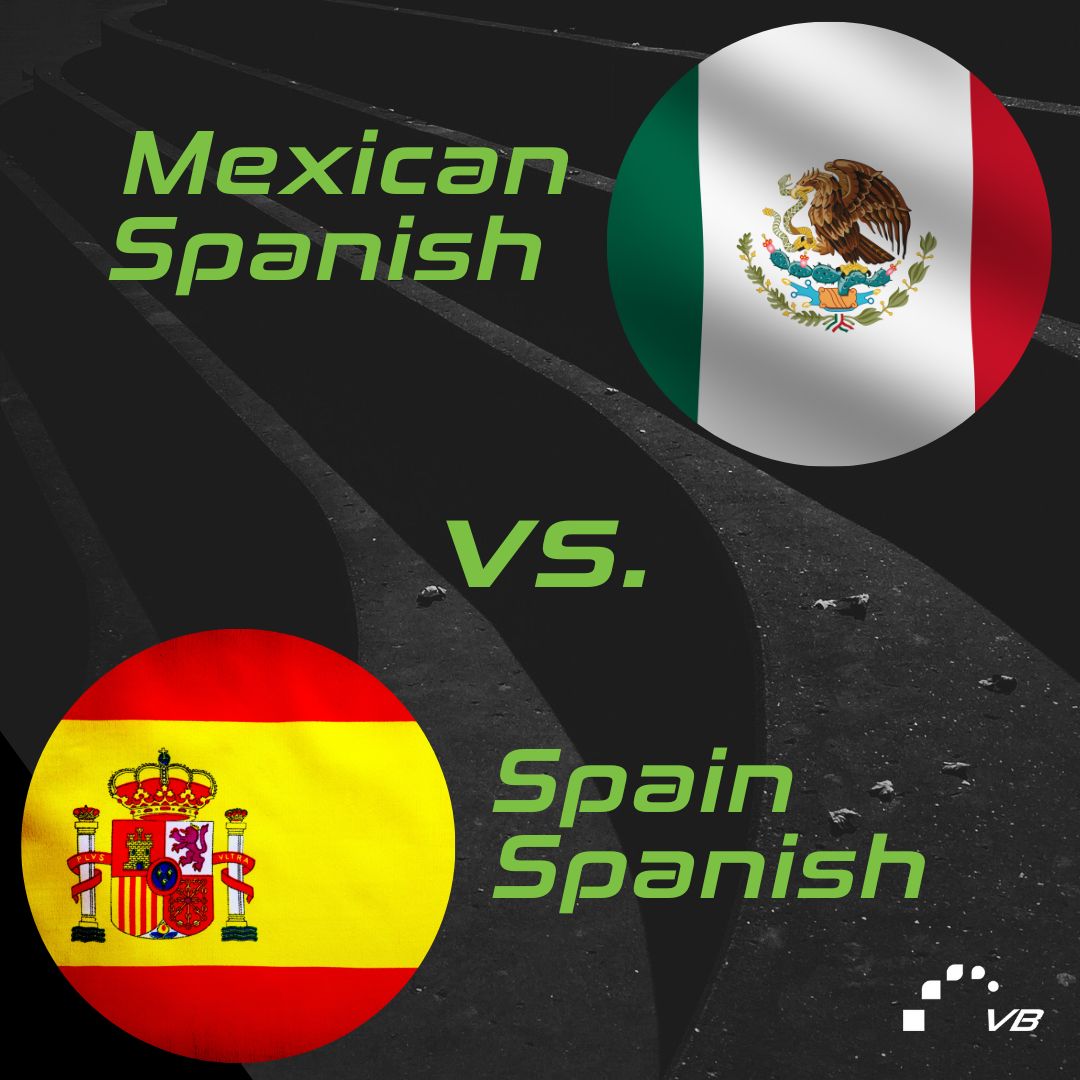
Spanish is a global language. It is a native language for more than 500 million people all around the world. It is also the official language in 20 countries. So if you are reading this blog post, you are probably thinking of which variant to learn – Mexican or Spain Spanish to learn.
Let us tell you some differences, a bit of history, and some guidance, along with some examples.
Let’s get started!
In the 15th century, the Spanish conquerors started colonizing the Americas to spread the word of God and get some valuable metals. They brought their languages with them, creating an influence. In Mexico, Nahuatl was still the official language for a relatively long period of time during the colonial era. By the early 19th century, many Spaniards lived in urban centers.
Mexico City (Tenochtitlán) was the capital of the Aztec Empire. Many people spoke the Aztec language Nahuatl. As a result, the speech went on to thrive there. This language had been outnumbering Spanish speakers for generations. Many people from Catalunia, Spain, escaped from the Francoist dictatorship and immigrated to Mexico, where they spoke the Catalan language. All of these influenced the language in Mexico dramatically.
The main differences between Mexican and Spain Spanish:
Mexican Spanish differs from Spain Spanish in some ways. For example, grammar, pronunciation, and vocabulary. Let’s have a look at some.
Grammar:
Past Tenses
Mexicans use both – past simple and present perfect tenses. But Spanish speakers prefer to use present perfect when discussing recently completed actions. In comparison, Mexicans prefer to use past simple. Let’s have a look at these examples:
I have drunk a cup of coffee this morning.
Mexican Spanish – Me tomé un café esta mañana.
Spain Spanish – He bebido un café esta mañana
I have been to Cancún this summer.
Mexican Spanish – Fui a Cancún este verano.
Spain Spanish – He ido a Cancún este verano.
Vosotros/as vs. Ustedes
Now let’s look at the differences between using vosotros/as and ustedes. In Spain, when talking to a group of people, vosotros/as is used. Meanwhile, in Mexican Spanish, people always use ustedes.
Here are some examples:
Mexican Spanish – Nunca puedo contar con ustedes.
Spain Spanish – Nunca puedo contar con vosotros.
Mexican Spanish – ¡Me encanta salir con ustedes!
Spain Spanish – ¡Me encanta salir con vosotros!
Mexican Spanish – Gracias a ustedes, pude conseguir este trabajo.
Spain Spanish – Gracias a vosotros, pude conseguir este trabajo.
Mexican Spanish – No sabía que ustedes ya se conocían.
Spain Spanish – No sabía que vosotros ya os conocías.
Tú/Usted vs. Vos
In Mexican Spanish, we use “tú”’ in informal speech and when we refer to one person, for example, a friend. And we use “Usted” in formal speech, for example, when talking to a senior or when meeting a person for the first time.
In some parts of Argentina, Uruguay, Bolivia, Chile, and Guatemala, you would need to use ‘vos‘, “Vos me dijiste que iba a ser una buena película” (“You told me it was going to be a good movie).
Spaniards, Mexicans, and other Latin Americans use ‘tú’ when talking to a friend or when addressing someone informally. If you want to ask ‘ “En realidad pensé que tú eras mucho menor. (“I actually thought that you were much younger”)
Leísmo and Laísmo
Leísmo is the incorrect usage of the indirect object pronoun “le” when we refer to a male. We must use the direct object pronoun “lo.”
In Spain, leísmo is very common. However, in Mexico and the rest of Latin America, the direct object pronoun “lo” is always used. Here is an example:
México: A Miguel no lo visité ayer. (the direct object pronoun is used correctly)
España: A Miguel no le visité ayer. (the direct object pronoun is used correctly)
It is important to note that leísmo is never used to refer to a woman or a group of people; the direct object pronoun “la” or “los” would be used.
Here are some examples of three forms of leismo in Spain Spanish:
Masculine: A Miguel no le visité ayer.
Feminine: A Maria no la visité ayer.
Plural: A Miguel y a Gabriela no los visité ayer.
Leísmo is never used in Mexican Spanish. Thus, we should use the direct object pronoun “lo” correctly and not use leísmo unless we are in Spain.
Vocabulary:
The Spain Spanish language was spoken in Mexico, and it “adopted” many words of Nahuatl origin (the language of the Aztecs) that are often used nowadays. Mexican Spanish has evolved with different characteristics to the language spoken in Spain.
Lime
Mexican Spanish – Limón
Spain Spanish – Lima
Potato
Mexican Spanish – Papa
Spain Spanish – Patata
Cake
Mexican Spanish – Pastel
Spain Spanish – Tarta
Mobile phone
Mexican Spanish – Celular
Spain Spanish – Móvil
To park
Mexican Spanish – Estacionar
Spain Spanish – Aparcar
Nahuatlisms and Aztequisms
In Mexican Spanish, there are also many words of Nahuatl origin. We call those words nahuatlisms or aztequisms. In the 16th century, Spanish vocabulary began to blend in words from Nahuatlbecause of colonizing people in Mesoamerica. For example, in Mexico, there are lots of toponyms (place names) of Nahuatl origin. In addition, nahuatlisms are often used when we mention fruits, objects, and animals that are of Mexican origin.
Below are such examples of nahuatlisms in Mexican Spanish:
Chapultepec: “cerro del chapulín”, from Nahuatl chapulín (grasshopper) and tepetl (hill or mountain).
Mazatlán: “lugar donde abundan los venados”, from Nahuatl mazatl (deer).
Michoacán: “lugar de pescadores”, from Nahuatl michín (fish).
Zacatecas: “gente de donde abunda el zacate”, from Nahuatl zacatl (grass).
Here are more examples of some words of Nahuatl origin in Mexican Spanish: guacamole (guacamole), chile (chili), chocolate (chocolate), aguacate (avocado), chicle (bubble gum), tlapalería (tlapaleria), chapopote (tar), tocayo (namesake), zopilote (buzzard), etc.
Pronunciation:
The Spanish colonies were founded in Mexico, the language was changing in its motherland, and the pronunciation was different from all the regions of Spain. That is why there is a possibility that the settlers in Mexico were from Andalusia, where a different pronunciation was used than the Castilian region.
There are 3 types of pronunciation in Spanish: distinción, el seseo and el ceceo. Most people in Mexico use seseo. Meanwhile, most people in Spain use distinción.
The letters “c” and “z”
Mexican Spanish – gracias (thanks) – /ɡɾˈasjas/
Spain Spanish – gracias (thanks) – /ɡɾˈaθjas/
Mexican Spanish -Conocer (to know) – /konoˈseɾ
Spain Spanish – Conocer (to know) – /konoˈθeɾ/
Mexican Spanish – Cerveza (beer) /seɾˈβesa/
Spain Spanish – Cerveza (beer) /θeɾˈβeθa/
Mexican Spanish – Barcelona /bˌaɾselˈona/
Spain Spanish -Barcelona /bˌaɾθelˈona/
Should I learn Mexican or Spain Spanish?
When you are unsure which variant of Spanish to learn, try to set clear goals. Ask yourself where and when you are going to use the language. Your goals will help you to decide which variant to learn.
For studying:
If you’re going to study at a university in Spain, then you should go for Spain Spanish.
Work purposes:
If you’re going to work in Mexico, you’d better choose Mexican Spanish.
Moving a country:
Perhaps, you’re going to move to another country, and on that occasion, you should learn the official language.
Your personal preferences:
Maybe you like Mexican Spanish more and are fascinated with Mexico. Then the choice is obvious.
Helping the Hispanic community:
As of today, there are about 61 million people of Hispanic people in the United States of America.
There are many organizations that help them with different aspects. For example, citizen education, money management, legal issues, media monitoring, medical care, immigration policy advocacy, etc.
You can become a volunteer to help those who are in need, and for that, speaking Spanish would be very helpful.
Whichever variant you choose, you can still contribute in more than one way!
SPEAK BUILD CONTRIBUTE
Used sources:
Godoy, S. (2021, July 14). Learn to use Voseo: Vos in Spanish. Homeschool Spanish Academy. Retrieved October 21, 2022, from https://www.spanish.academy/blog/learn-to-use-voseo-vos-in-spanish/
Michael. (2021, January 14). 5 Diferencias – Español Europeo y Mexicano. Language Tsar. Retrieved October 21, 2022, from https://languagetsar.com/las-5-diferencias-mas-importantes-entre-el-espanol-europeo-y-el-espanol-mexicano/
Michele. (2021, February 11). 7 top differences between Spain Spanish and Latin American Spanish you didn’t know. The Intrepid Guide. Retrieved October 21, 2022, from https://www.theintrepidguide.com/differences-between-latin-american-spanish-spain-spanish/
Moodie, A. (2022, September 15). Resources for Hispanic immigrants and their families. Boundless. Retrieved October 21, 2022, from https://www.boundless.com/blog/resources-for-hispanic-immigrants/
Orozco, M. (2020, November 4). 102 differences Mexican Spanish and Spain spanish. Spanish Unlocked. Retrieved October 21, 2022, from https://spanishunlocked.com/what-are-the-differences-between-mexican-spanish-and-spain-spanish/
Wikimedia Foundation. (2022, October 21). Spanish language. Wikipedia. Retrieved October 21, 2022, from https://en.wikipedia.org/wiki/Spanish_language
Easter traditions in the USA, Germany, and Mexico
People celebrate Easter in many countries and have different traditions
6 Tips to defend your point of view in English
Standing up and defending your point of view might be
International Women’s Day
International Women's Day is celebrated every year on March 8th.






